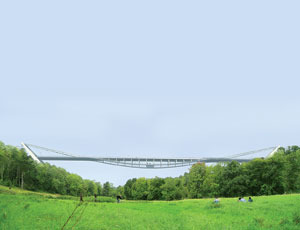Alow-profile 350-meter-long, 15-m-wide suspension bridge designed by a U.K.-French team will carry part of a 25.5-kilometer planned light-rail system, called Metro West, across Dublin’s Liffey River to the city’s northeast corner.
The Irish government’s Railway Procurement Agency, which oversaw design competition, wanted a low-key design. “Because it’s sensitive, we didn’t want [tall] towers,” says Davood Liaghat, technical director at Buro Happold Consultants Ltd., Bath, U.K. The structural firm, with Paris-based Explorations Architecture S.A., won RPA’s com-petition and a $190,000 prize.

“We decided to lean the towers back to [match] the tree levels,” adds Liaghat. Having the towers rise just 20.7 m means running the main cables under the deck for two-thirds of the crossing. Inclined steel box struts, up to 9.3 m long, will rise from the cables to support the 2-m-deep box girder deck. Both main cables also will carry pedestrian walkways, which will be linked midway to ease access and increase lateral stiffness.
The designers will help RPA secure planning approval for the bridge. Later this year, RPA will start procuring Metro West as a public-private partnership, says RPA project manager Tom O’Riley.
Whoever wins the light-rail contract will have responsibility for the estimated $60-million bridge design, but they will have to stick closely to the low-profile scheme. “There may be scope for slight modifications,” O’Riley says.


Post a comment to this article
Report Abusive Comment